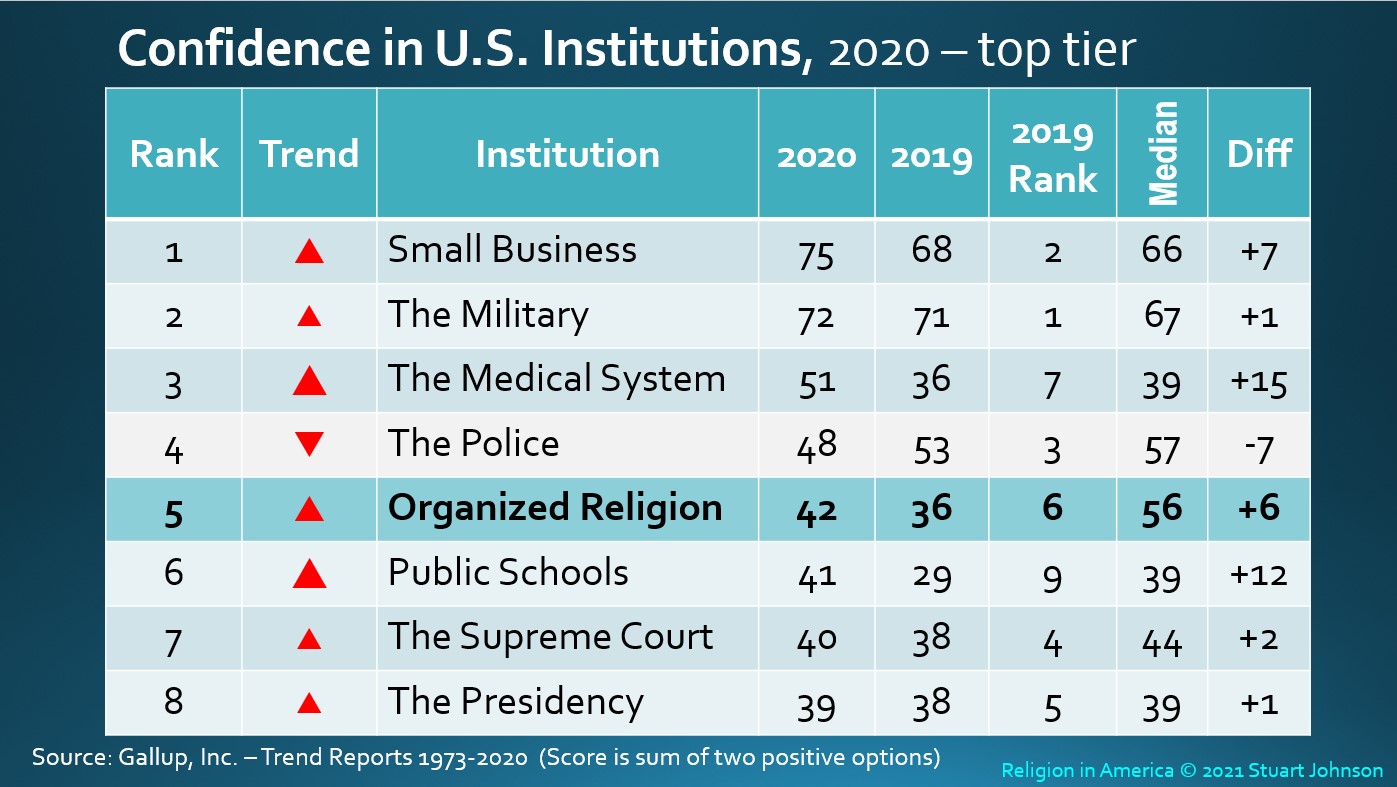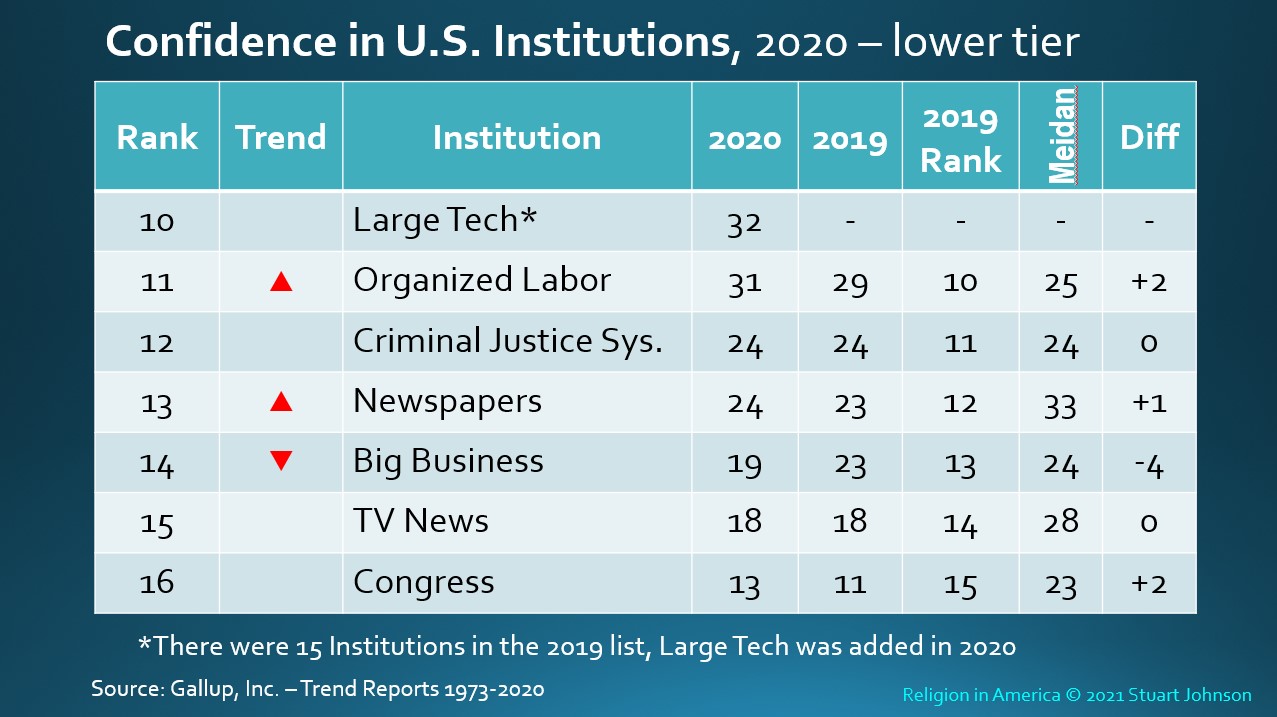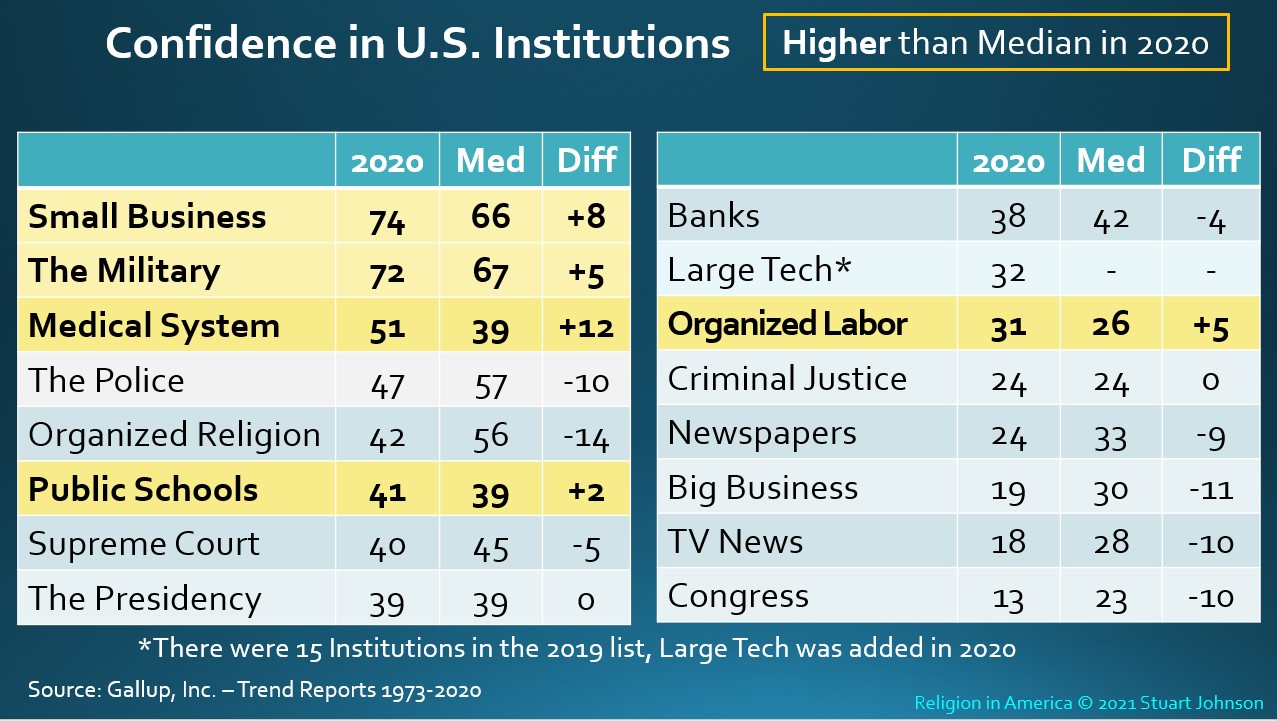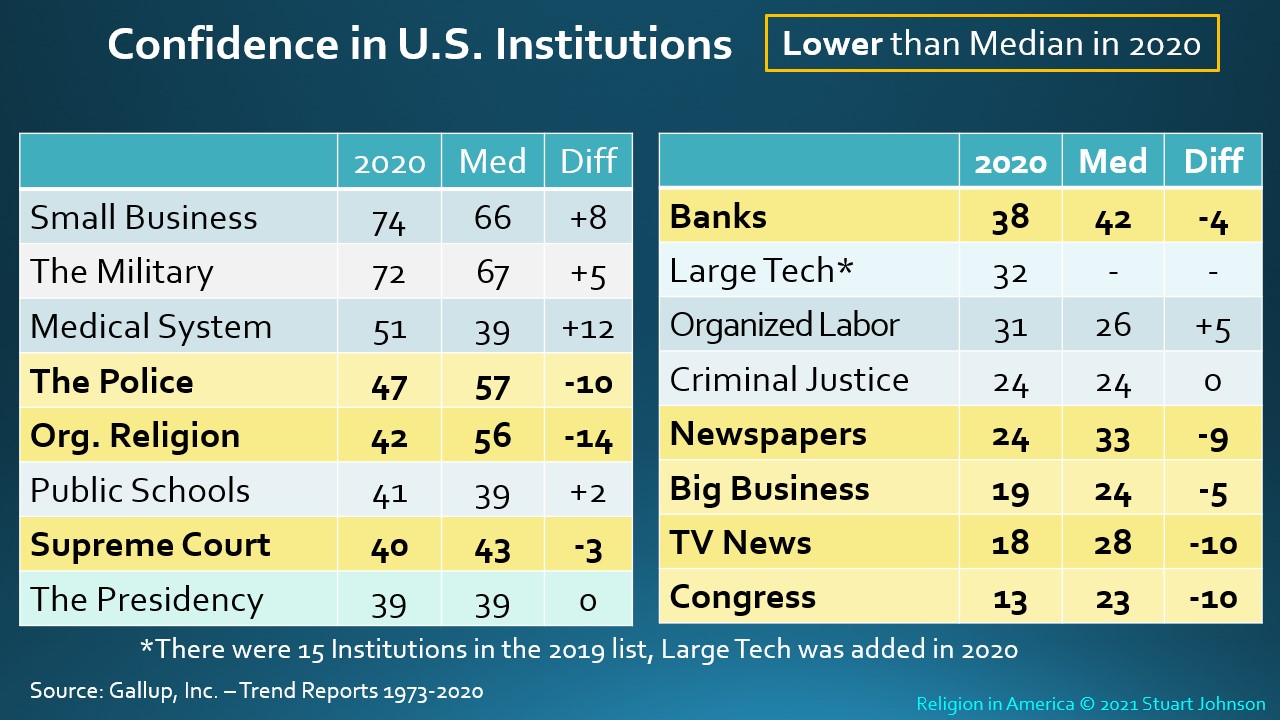
Making Information Make Sense
Religion in America
Digging Deeper: Confidence
updated June 28, 2021
< back to Religion in America summary
NOTE: This page is based on the 2020 report. An update with 2021 data is coming soon.
Summary
The following charts provide more detail for the Gallup survey of Confidence in U.S. Institutions. Gallup began this survey in 1973, asking people about their confidence in 15 major institutions. Over the years, the number has varied between 15 and 16 (those added since 1973 are indicated in brackets on the chart in the Summary.
The Details
Figure 1 - Confidence in U.S. Institutions - 2020 Top Tier
The confidence score is the percentage of respondents indicating a "great deal" or "quite a lot" of confidence in an institution (compared to those expressing "some" or "very little"). The arrow indicates the direction of change from 2019, with the size of the arrow signifying relative magnitude of the change.
Because of the COVID-19 pandemic, some of what is stated as increased confidence may actually be a form of sympathy for people associated with institutions particularly affected. The Gallup confidence survey is conducted during the summer, which would have been during the early months of the pandemic when the first surges were accompanied by increasing restrictions and lockdowns. .
Only the top 3 garnered expressions of confidence by a majority of respondents, and the Medical System by the slimmest of margins. The Police dropped 7 points and 1 rank from 2019 in response to the national reaction to the killing of George Floyd by Minneapolis police. That was the sharpest downtune among the 16 institutions measured in 2020, yet it retains a position only two points below the majority threshold.
Organized Religion, which had slipped to 36% in 2019, its lowest point every, rebounded by 6 points and moved up one place in the ranking. This also seems to be clearly linked to the impact of the pandemic as people sought comfort and hope amidst the onliness and anxiety of restrictions and lockdowns. The interesting thing, however, is that the response by religious bodies had to seek new avenues of expression, with many turning to technology—live streaming, YouTube, Zoom—to provide a means of connecting when live gatherings were either not possible or greatly reduced in number.
The Supreme Court and The Presidency remained in the upper tier of institutions, changing little in confidence, but slipping three places each in their ranking because The Medical System, Organized Religion and Public Schools all moved up in the ranking.
Figure 2 - Confidence in U.S. Institutions - 2020 Lower Tier
Compared to the Top Tier, there is little movement in the Lower Tier. The introduction of Large Tech, in fact, produced all of the change in ranking for the others, pushing each of them down one rank. Otherwise, Organized Labor and Newspapers moved up slightly in confidence over 2019, while Big Business dropped and the others remained the same. Large Tech entered the survey with only a one-third confidence level among respondents.
It is clear, especially with the survey being conducted in the early months of the pandemic and following the early reactions to the death of George Floyd but before the November election, that most of the changes occurred in the upper tier to the groups most affected by the pandemic and George Floyd-inspired demonstrations and riots. The messengers and political actors (Newspapers, TV News, Supreme Court, The Presidency,Criminal Justice System, and Congress) seemed untouched, but remember that it was still early in the total turmoil of 2020, and results later in the year could have revealed greater change).
The 2021 survey should provide a clearer picture of any additional changes or a return to previous levels.
Figure 3 - Confidence in U.S. Institutions - 2020 Higher Than Media
Each of the following two charts show the 16 institutions covered in the 2020 survey in rank order. Figure 3 highlights those whose 2020 score is higher than the median (the point where half the scores over time are higher and half lower). Figure 4 highlights those whose 2020 score is lower than the median.
Five of the 16 institutions had scores in 2020 above their historic median. As suggested above, Small Business, The Medical System, and Public Schools all seem to be tied to the pandemic and could shrink back toward previous levels post-pandemic.
The Military has undergone a path responsive to military action and politics. It started at 56% in 1973, descended to a low of 50% in 1981. It peaked at 85% for the first Gulf War in 1991 and again for the Iraq War following September 11 in 2003, when it hit 82%, Both were surrounded by years when the level moved upward. It hit 82% again in 2009, dropped to 66% in 2013, then has hovered between 71 and 74% since then.
Organized Labor, which has hit 31% only twice since 1973 (2004 and 2020), started at 29% in 1973, hit a low of 19% in 2007 and 2009, but essentially has drifted between 20% and 30%.
Figure 4 - Confidence in U.S. Institutions - 2020 Lower Than Median
As we saw in Figure 3, five of the 16 institutions included in the Gallup survey had 2020 scores above their median. Two (The Presidency and The Criminal Justice System had 2020 scores that matched their median scores. Large Tech was new in 2020, so has no history yet. That leaves fully half of institutions in the Gallup survey whose 2020 score was below their historic median.
Organized Religion, still ranked Number 5 with the relatively strong score of 42 is, however, 14 points below its median of 56. Religion started with 65% confidence in 2973, reached its high of 68% in 1975, then drifted down until falling below 60% from 1988 to 2001, when it hit 60% again in the summer before the September 11 terrorist attacks. The following year, it dropped to 45%, rebounded slightly before dropping permanently below 50% in 2010, After staying in the mid- to upper-40s, it fell to 36% in 2019, before what appears to be a pandemic-inspired bounce back to 42% in 2020. With that trajectory, it would seem that Organized Religion should have fallen from the top to the bottom of the list, yet it was Number 5 in 2020. The erosion of confidence is even more widespread.
Congress is 10 points below its historic median of 23%, half that of Organized Religion.
Congress started at 42% in 1973, dropped to 29% by 1984 before rebounding to 41% by 1986 (half way through Reagan's second term as president). From there it went down to 24% in 1990 following by a Gulf War bounce to 30% in 1991, then tumbling to 18% in 1992. It began to rise again toward the end of Clinton's second term and reached 30% by 2004. By the time George Bush finished his second term, Congress' confidence level was down to 12%. It rose slightly during Obama's first term, but fell to its low of 7% in 2014. During Trump's single term it rose, but only to slightly above 10%, rising to 13% by 2020, which puts it indisputably at last place in confidence among the 16 institutions.
TV News is not far behind Congress, also 10 points below its median of 28%. Gallup added TV News to the Institutional Confidence survey in 1993 when network news was beginning to be challenged by cable and the 24-hour news cycle. Confidence has steadily eroded. After starting at 46% confidence in 1993, it immediately fell into the mid-30s. By 2007 (the end of George Bush's second term and before the election of Barack Obama) confidence had dropped into the 20s, hit 18% in 2014, rebounded for a few years above 20%, then back to 18% for 2019 and 2020. By the time of the 2016 and 2020 elections, competition from and influence by social media had become major factors in American politics and elections. The once dominant role of TV News from three major networks has exploded into a dizzying array of sources which contribute to the volatile political environment, reflected in falling levels of confidence.
The Police is also 10 points below its median, but at 57% that median in much stronger than Congress or TV News, so it remains in the top-five of institutions. Gallup added The Police in 1993, the same year as TV News, but its decline has been much slower and narrower. Starting with 52% confidence in 1993, It reached a high of 64% in 2004. By 2015 The Police hit a low of 52% in 2015, then bounced back some, with 53% in 2019. That was before George Floyd. By 2020, the confidence level fell 5 points to its all-time low of 48%. That, however, represents a drop of 16% from the high of 64%, compared to a 35 point drop for Congress and 28 points for TV News, neither of which ever reached 50% confidence.
Newspapers have dropped 9 points from its median of 33%. Newspapers have been in the Institutional Confidence survey from the beginning. Starting at 39% confidence in 1973, it climbed to 51% by 1978, but then slipped into the 30s from 1981 through 2004 when it was at 30%. After one year at 28%, it rose again to 30% in 2006. After that it has wavered in the 20s, hitting a low of 20% in 2016, a high of 28% in 2011, then ending at 24% in 2020.
Also below their historic medians, but above their lowest confidence score, are Big Business (5 points below its median of 24%), Banks (points below its median of 42%), and the Supreme Court (3 points below its median of 43%). Big Business, listed since 1973, started at 26%, has ranged between 17% and 34%, ending at 19% for 2020. Banks started at 60% in 1979, when it was added to the survey. It has ranged between 21% and 60%, ending at 38% in 2020. The Supreme Court started at 45% in 1973, has ranged between 30% and 56%, ending at 40% for 2020.
Religion in America
Digging Deeper: Confidence
updated June 28, 2021
< back to Religion in America summary
NOTE: This page is based on the 2020 report. An update with 2021 data is coming soon.
Summary
The following charts provide more detail for the Gallup survey of Confidence in U.S. Institutions. Gallup began this survey in 1973, asking people about their confidence in 15 major institutions. Over the years, the number has varied between 15 and 16 (those added since 1973 are indicated in brackets on the chart in the Summary.
The Details
Figure 1 - Confidence in U.S. Institutions - 2020 Top Tier
The confidence score is the percentage of respondents indicating a "great deal" or "quite a lot" of confidence in an institution (compared to those expressing "some" or "very little"). The arrow indicates the direction of change from 2019, with the size of the arrow signifying relative magnitude of the change.
Because of the COVID-19 pandemic, some of what is stated as increased confidence may actually be a form of sympathy for people associated with institutions particularly affected. The Gallup confidence survey is conducted during the summer, which would have been during the early months of the pandemic when the first surges were accompanied by increasing restrictions and lockdowns. .
Only the top 3 garnered expressions of confidence by a majority of respondents, and the Medical System by the slimmest of margins. The Police dropped 7 points and 1 rank from 2019 in response to the national reaction to the killing of George Floyd by Minneapolis police. That was the sharpest downtune among the 16 institutions measured in 2020, yet it retains a position only two points below the majority threshold.
Organized Religion, which had slipped to 36% in 2019, its lowest point every, rebounded by 6 points and moved up one place in the ranking. This also seems to be clearly linked to the impact of the pandemic as people sought comfort and hope amidst the onliness and anxiety of restrictions and lockdowns. The interesting thing, however, is that the response by religious bodies had to seek new avenues of expression, with many turning to technology—live streaming, YouTube, Zoom—to provide a means of connecting when live gatherings were either not possible or greatly reduced in number.
The Supreme Court and The Presidency remained in the upper tier of institutions, changing little in confidence, but slipping three places each in their ranking because The Medical System, Organized Religion and Public Schools all moved up in the ranking.
Figure 2 - Confidence in U.S. Institutions - 2020 Lower Tier
Compared to the Top Tier, there is little movement in the Lower Tier. The introduction of Large Tech, in fact, produced all of the change in ranking for the others, pushing each of them down one rank. Otherwise, Organized Labor and Newspapers moved up slightly in confidence over 2019, while Big Business dropped and the others remained the same. Large Tech entered the survey with only a one-third confidence level among respondents.
It is clear, especially with the survey being conducted in the early months of the pandemic and following the early reactions to the death of George Floyd but before the November election, that most of the changes occurred in the upper tier to the groups most affected by the pandemic and George Floyd-inspired demonstrations and riots. The messengers and political actors (Newspapers, TV News, Supreme Court, The Presidency,Criminal Justice System, and Congress) seemed untouched, but remember that it was still early in the total turmoil of 2020, and results later in the year could have revealed greater change).
The 2021 survey should provide a clearer picture of any additional changes or a return to previous levels.
Figure 3 - Confidence in U.S. Institutions - 2020 Higher Than Media
Each of the following two charts show the 16 institutions covered in the 2020 survey in rank order. Figure 3 highlights those whose 2020 score is higher than the median (the point where half the scores over time are higher and half lower). Figure 4 highlights those whose 2020 score is lower than the median.
Five of the 16 institutions had scores in 2020 above their historic median. As suggested above, Small Business, The Medical System, and Public Schools all seem to be tied to the pandemic and could shrink back toward previous levels post-pandemic.
The Military has undergone a path responsive to military action and politics. It started at 56% in 1973, descended to a low of 50% in 1981. It peaked at 85% for the first Gulf War in 1991 and again for the Iraq War following September 11 in 2003, when it hit 82%, Both were surrounded by years when the level moved upward. It hit 82% again in 2009, dropped to 66% in 2013, then has hovered between 71 and 74% since then.
Organized Labor, which has hit 31% only twice since 1973 (2004 and 2020), started at 29% in 1973, hit a low of 19% in 2007 and 2009, but essentially has drifted between 20% and 30%.
Figure 4 - Confidence in U.S. Institutions - 2020 Lower Than Median
As we saw in Figure 3, five of the 16 institutions included in the Gallup survey had 2020 scores above their median. Two (The Presidency and The Criminal Justice System had 2020 scores that matched their median scores. Large Tech was new in 2020, so has no history yet. That leaves fully half of institutions in the Gallup survey whose 2020 score was below their historic median.
Organized Religion, still ranked Number 5 with the relatively strong score of 42 is, however, 14 points below its median of 56. Religion started with 65% confidence in 2973, reached its high of 68% in 1975, then drifted down until falling below 60% from 1988 to 2001, when it hit 60% again in the summer before the September 11 terrorist attacks. The following year, it dropped to 45%, rebounded slightly before dropping permanently below 50% in 2010, After staying in the mid- to upper-40s, it fell to 36% in 2019, before what appears to be a pandemic-inspired bounce back to 42% in 2020. With that trajectory, it would seem that Organized Religion should have fallen from the top to the bottom of the list, yet it was Number 5 in 2020. The erosion of confidence is even more widespread.
Congress is 10 points below its historic median of 23%, half that of Organized Religion.
Congress started at 42% in 1973, dropped to 29% by 1984 before rebounding to 41% by 1986 (half way through Reagan's second term as president). From there it went down to 24% in 1990 following by a Gulf War bounce to 30% in 1991, then tumbling to 18% in 1992. It began to rise again toward the end of Clinton's second term and reached 30% by 2004. By the time George Bush finished his second term, Congress' confidence level was down to 12%. It rose slightly during Obama's first term, but fell to its low of 7% in 2014. During Trump's single term it rose, but only to slightly above 10%, rising to 13% by 2020, which puts it indisputably at last place in confidence among the 16 institutions.
TV News is not far behind Congress, also 10 points below its median of 28%. Gallup added TV News to the Institutional Confidence survey in 1993 when network news was beginning to be challenged by cable and the 24-hour news cycle. Confidence has steadily eroded. After starting at 46% confidence in 1993, it immediately fell into the mid-30s. By 2007 (the end of George Bush's second term and before the election of Barack Obama) confidence had dropped into the 20s, hit 18% in 2014, rebounded for a few years above 20%, then back to 18% for 2019 and 2020. By the time of the 2016 and 2020 elections, competition from and influence by social media had become major factors in American politics and elections. The once dominant role of TV News from three major networks has exploded into a dizzying array of sources which contribute to the volatile political environment, reflected in falling levels of confidence.
The Police is also 10 points below its median, but at 57% that median in much stronger than Congress or TV News, so it remains in the top-five of institutions. Gallup added The Police in 1993, the same year as TV News, but its decline has been much slower and narrower. Starting with 52% confidence in 1993, It reached a high of 64% in 2004. By 2015 The Police hit a low of 52% in 2015, then bounced back some, with 53% in 2019. That was before George Floyd. By 2020, the confidence level fell 5 points to its all-time low of 48%. That, however, represents a drop of 16% from the high of 64%, compared to a 35 point drop for Congress and 28 points for TV News, neither of which ever reached 50% confidence.
Newspapers have dropped 9 points from its median of 33%. Newspapers have been in the Institutional Confidence survey from the beginning. Starting at 39% confidence in 1973, it climbed to 51% by 1978, but then slipped into the 30s from 1981 through 2004 when it was at 30%. After one year at 28%, it rose again to 30% in 2006. After that it has wavered in the 20s, hitting a low of 20% in 2016, a high of 28% in 2011, then ending at 24% in 2020.
Also below their historic medians, but above their lowest confidence score, are Big Business (5 points below its median of 24%), Banks (points below its median of 42%), and the Supreme Court (3 points below its median of 43%). Big Business, listed since 1973, started at 26%, has ranged between 17% and 34%, ending at 19% for 2020. Banks started at 60% in 1979, when it was added to the survey. It has ranged between 21% and 60%, ending at 38% in 2020. The Supreme Court started at 45% in 1973, has ranged between 30% and 56%, ending at 40% for 2020.
©2025 Stuart Johnson & Associates
Resouce Center | Contact Us
©2025 Stuart Johnson & Associates



